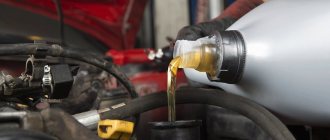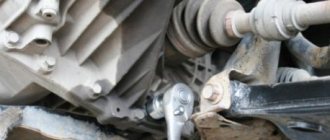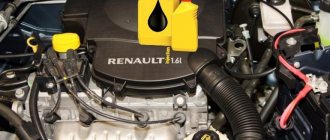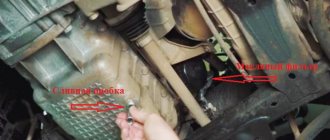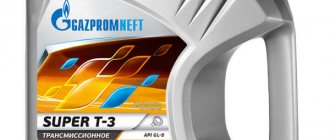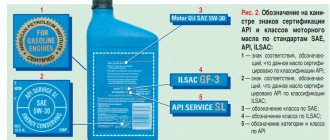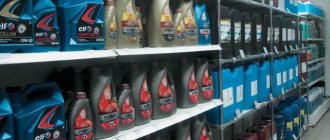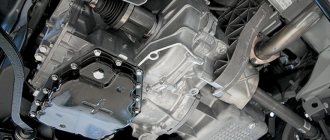Short description
Transmission oil TAD-17 is made by distilling sulfur category oil. The process removes excess hydrocarbon compounds and foreign impurities from the composition. This approach guarantees the utmost purity of the mineral base.
The formula is supplemented with a complex of highly specialized additives. Additional components increase the performance of the base. The main components are depressant, detergent, and dispersant additives. The result of mixing is the optimization of temperature resistance, increasing the protective characteristics of the liquid.
Where is TAD-17 oil used?
The operation of the transmission is associated with constant high friction of parts, high pressure on the gears, high sliding speed and a significant temperature range.
A special transmission fluid is necessary to create the thinnest but strongest film, which, covering the system elements, protects them from rapid wear. At the same time, the oil composition must prevent squeezing out the lubricant from the meshing points and have special extreme pressure properties to prevent premature damage to gear teeth and welding of parts due to overheating. TAD-17 fully meets these requirements.
TAD-17 is poured into manual transmissions and used as a lubricant for drive axles and transfer cases, as well as manual control systems. This fluid is compatible with five types of gears:
- cylindrical;
- worm;
- conical;
- spiral-conical;
- hypoid.
TAD-17 oil is designed for passenger cars and trucks of Russian brands - VAZ, UAZ, KamAZ, etc. It is also used in agricultural units (tractors, combines), electric vehicles, equipment for industrial production and repair. Product described:
- increases the wear resistance of transmission system elements;
- protects them from jamming;
- prevents overheating of parts, has the required degree of heat resistance;
- has an anti-corrosion effect on metal;
- reduces the noise of the operating transmission.
Please note: in retail the liquid is sold both in factory containers of various sizes and for bottling.
Where is TAD-17 used?
The lubricant is designed for servicing manual gearboxes, transmission units, gearboxes, and axles of passenger cars. The oil meets the requirements of light trucks and passenger cars. Suitability for use in agricultural, construction and highly specialized equipment is also noted.
The lubricant effectively protects hypoid, worm, and cylindrical gears.
Changing transmission oil
How to make a Sherpa all-terrain vehicle with your own hands: technical specifications, drawings and dimensions, design diagram, analogues
The lubricant in the gearbox must be changed at the intervals specified in the operating manual. In addition, it is necessary to take into account the recommendations of the car manufacturer specified in the service book.
Replacing transmission consumables is not carried out as often as changing engine lubricant. You can pour mineral water into the gearbox, but universal or synthetic petroleum products are usually used.
Before pouring new oil, you need to find out what kind of lubricant has already been poured into the transmission unit. However, you can always use imported analogues of TAD-17, which have high performance indicators.
https://youtube.com/watch?v=Yh9re8sX_cM%3F
Remember that if a petroleum product begins to smell bad, in other words, stink, it needs to be replaced. A burning smell indicates the exhaustion of the service life. A sharp change in color is also a sign that the consumable needs to be changed. Do not delay replacement until later, otherwise various problems may occur in your car.
There are several systems whose performance determines the functioning of the vehicle. For example, a malfunction of the brakes can lead to an accident, and boiling of the anti-freeze agent in the expansion tank can lead to serious engine repairs. The gearbox also needs to be taken care of. Only high-quality lubricant can help with this.
Transmission oil TAD-17 is a prominent representative of the group of domestic lubricants for gearboxes. I have always noted two significant parameters for this product - low cost and wide scope of application
Of course, other parameters are also very important, so let's take a comprehensive look at the lubricant and find out whether it is of high quality
Main settings
Oil TAD 17 technical characteristics:
| Index | Meaning |
| Kinematic viscosity at +50˚С | 115 |
| Kinematic viscosity at +100 ˚С | 17,5 |
| Viscosity index | 100 |
| Ignition threshold in an open crucible ˚С | +200 |
| Crystallization threshold ˚С | -25 |
| Sulfate ash content | 0,3% |
| Sulfur content % | 2 |
| SAE Compliance | 85W90 |
| Category | GL-5 |
Tad-17: price per liter
The price range for this brand of gear oil is determined by the financial policy of the manufacturers, as well as the packaging of the products. The price range for the product varies depending on its packaging:
- In large packaging (barrels of 180...195 kg) - up to 55 rubles/l.
- In medium packaging (20 l canisters) – up to 80 rubles/l.
- In small packaging (1 liter canisters) – up to 100 rubles/liter.
Dumping the price of Tad-17 may indicate poor-quality technology for preparing the lubricant, the likelihood of its dilution during the packaging process, as well as the replacement of some components with cheaper analogues. Therefore, in doubtful situations, it makes sense to familiarize yourself with the product certificate and check whether the technical characteristics of the lubricant comply with the current standards.
Tep-15 or Tad-17, which is thicker? Differences
Tep-15 or Tad-17: differences
Tep-15 or Tad-17? If we consider the chemical composition of these lubricants, there will be few differences. Both are classified as mineral, since they are made through the process of distillation and refining of certain types of oil. Tep-15 is cheaper, and therefore the concentration of extreme pressure and anti-wear additives is reduced. In addition, the viscosity of Tep-15 is somewhat lower, although for many moving parts of cars (especially domestic production) this indicator is not critical.
The safety of using the transmission lubricants under consideration is determined not only by the intensity of their thickening at low temperatures (for Tad-17 the operating temperature range is -20 to +135ºС, and for Tep-15 from -23 to +130ºС), but also by the degree of chemical aggressiveness towards gland seals. In this sense, Tad-17 is more active. It contains sulfur and phosphorus in larger quantities, which promotes mechanochemical reactions on the surface of hypoid gear parts. As a result of such reactions, films are formed there that increase the extreme pressure ability of the material under conditions of high sliding speeds of one transmission element over an adjacent one. In such conditions, not all brands of rubber seals may have sufficient wear resistance. Moreover, if the synchronizer is made of copper or a copper alloy, then its durability will be reduced.
On the contrary, Tep-15, which does not contain such a quantity of chemically active reagents, is less sensitive to the degree of oil resistance of rubber and the grade of copper alloys.
What is thicker - Tep-15 or Tad-17?
When making comparisons, it is important to evaluate not only the absolute value of viscosity, but also its change as the temperature increases. Oil brand Tep-15 according to GOST 17479.2-85 belongs to gear oils of group 2, it contains only anti-wear additives, and therefore is designed for effective use under external loads up to 2 GPa and volumetric temperatures up to 130ºС
At the same time, Tad-17 also includes extreme pressure additives and belongs to group 5, for which external loads on shafts and gears can reach 3 GPa or more, at bulk temperatures up to 150ºС
Oil brand Tep-15 according to GOST 17479.2-85 belongs to gear oils of group 2, it contains only anti-wear additives, and therefore is designed for effective use under external loads up to 2 GPa and volumetric temperatures up to 130ºС. At the same time, Tad-17 also includes extreme pressure additives and belongs to group 5, for which external loads on shafts and gears can reach 3 GPa or more, at bulk temperatures up to 150ºС.
Thus, the optimal units for the use of Tep-15 are cylindrical, bevel and - partially - worm gears, which operate at relatively low sliding speeds, and for Tad-17 - predominantly hypoid gears, where such speeds reach 5...7% of the rotation speed gear pair. Accordingly, the wear rate in such conditions increases from 0.4 to 0.5.
An assessment of the stability of viscosity indicators depending on the temperature in the volume of the unit gives the following values. For Tep-15, the viscosity changes as follows:
- At 100ºС – 15…16 mm2/s.
- At 50ºС – 100…120 mm2/s.
- At 20ºС – 870…1150 mm2/s.
Accordingly, similar indicators for Tad-17 are:
- At 100ºС – 18…20 mm2/s.
- At 50ºС – 180…220 mm2/s.
- At 20ºС – 1500…1600 mm2/s.
Still, Tep-15 or Tad-17? Comparing the performance of lubricants, we come to the conclusion that the load capacity of transmission oil of the Tad-17 brand is higher, therefore, it can be used at increased loads on the mechanism, where the long-term existence of a surface oil film separating the rubbing parts is mandatory. At the same time, Tep-15 is more effective for use in transmissions of tractors, as well as medium-duty trucks.
https://youtube.com/watch?v=iK98zj0h2wA
TAD 17 oil is a universal composition for all-season use
The transmission consists of moving parts that interact with each other. The tasks of the component are to transfer force from the engine to the wheels and change the torque of the motor. During operation, all parts rotate at high speed, subject to high sliding and friction loads, which in turn create high temperatures (more than 120°C). Oil is used to protect spare parts.
The lubricant has the following advantages:
- increases wear resistance of friction clutches;
- prevents the formation of pitting - corrosion pits, due to which jamming and jamming occur;
- removes heat from the surface;
- reduces the operating noise of the component;
- keeps processed products in suspension and prevents them from settling on surfaces.
https://youtube.com/watch?v=iK98zj0h2wA
The name TAD is an abbreviation that stands for “transmission automobile distillate.” Therefore, it is incorrect to call this product TAT. This is mistake. Distillate oil is a product of oil purification (distillation) and its subsequent processing by various methods. Such compositions are not treated with acids and alkalis. The letter “I” at the end of the marking means that the composition contains a complex additive that prevents the formation of corrosion, oxidation, and evaporation. Number 17 is an indicator of kinematic viscosity.
Composition parameters and its use
According to SAE, TAD 17I oil is classified as 85W-90. This means that it is applicable at temperatures from -25 to +140°C. The American Petroleum Institute (API) classifies the product as GL-5. In accordance with it, the composition contains at least 6.5% extreme pressure additives.
In the CIS countries, lubricants are divided into 5 groups. The higher the number, the higher the characteristics of the composition. TAD 17 oil belongs to the fifth group. It is also certified according to TR CU 030/2012 (customs union requirements) and GOST 23562-79.
Product Main Features:
Composition and labeling
Transmission oil Tad-17, produced in accordance with the technical requirements of GOST 23652-79 (as well as its closest analogue - oil Tad-17i), is intended for use in domestic passenger cars. Suitable for manual transmissions (especially hypoid ones), drive axles, and some control systems of passenger cars with a classic rear-wheel drive layout. According to the international classification, it belongs to class GL-5 oils. It is not used in transmissions of trucks and heavily loaded special equipment, since it has initially increased viscosity, which increases the vehicle control effort (in such cases, Tep-15 lubricant is more in demand).
The composition of transmission oil Tad-17 includes:
- Naphthenic oil with a density of at least 860 kg/m3.
- Distillate oil.
- Extreme pressure additives containing sulfur and phosphorus.
- Anti-wear additives based on molybdenum disulfide.
- Other components (anti-foam, anti-delamination, etc.).
It is difficult to indicate the exact chemical composition of the lubricant in question, since manufacturers consider the percentage of additives they use to be their “know-how”, and often recommend “their” oil for certain types of vehicles. Explanation of markings: T - transmission, A automobile, D - designed for long-term operation, 17 - average value of kinematic viscosity of the oil, mm2/s at 100ºC. Please note that recently this marking has been considered obsolete and is gradually being replaced by a new one, adapted to international requirements. This marking is given in GOST 17479.2-85.
In everyday expressions, Tad-17 lubricant is often called nigrol, although the chemical composition of nigrol is different in many ways: it contains practically no additives, and the actual range of parameters is wider than that of Tad-17.
Technical characteristics of TAD-17 (GOST 23652-79)
TAD-17 (TM-8-15) is a universal all-season mineral gear oil of API GL-5 class and SAE 85W90 viscosity.
Explanation:
- T – transmission.
- A – for vehicles.
- D – distillate oil.
- 17 – viscosity at +100 °C.
The letter “I” in the product variation TAD-17I (TM-5-18) means that imported ingredients are used in the additives.
Designed for lubrication of cylindrical, bevel, worm, spiral bevel and hypoid gears. Used in drive axles and manual transmissions of domestic passenger cars. The lubricant is used in winch gearboxes, canopies of agricultural and construction machinery, and drives of stationary technical equipment.
Poured into equipment operating in difficult weather conditions, under loads up to 3000 MPa and high sliding speeds:
- Cars and trucks.
- Road construction equipment.
- Factory equipment.
- Buses, diesel locomotives.
Produced on the basis of a highly purified mineral base with a small inclusion of sulfur.
The composition contains sulfur-phosphorus-containing, depressant, and anti-foam additives developed by Russian manufacturers. Operates from -25 to +130-140 °C.
Properties of TAD-17:
- Kinematic viscosity at 100 °C – 17.5.
- Density at +15°C – 0.907.
- Solidifies at -25 °C (not suitable for the Far North - at -25 °C it becomes fluid).
- The ignition temperature of vapors is +200.
- The phosphorus content due to additives is 0.1%. Sulfur content – 2%.
- Sulfated ash content – no more than 0.3%.
Manufacturers: Lukoil, OILRIGHT, Volga-Oil, Rosneftesintez, SINTOIL.
